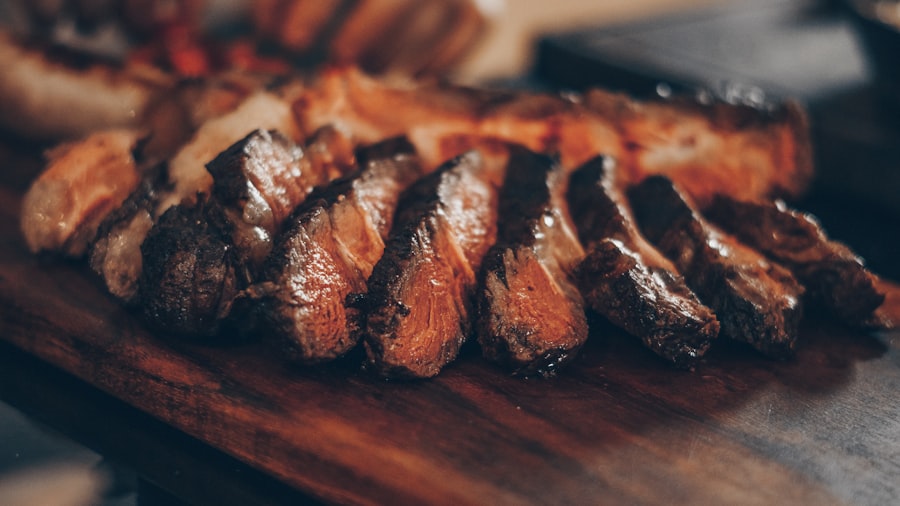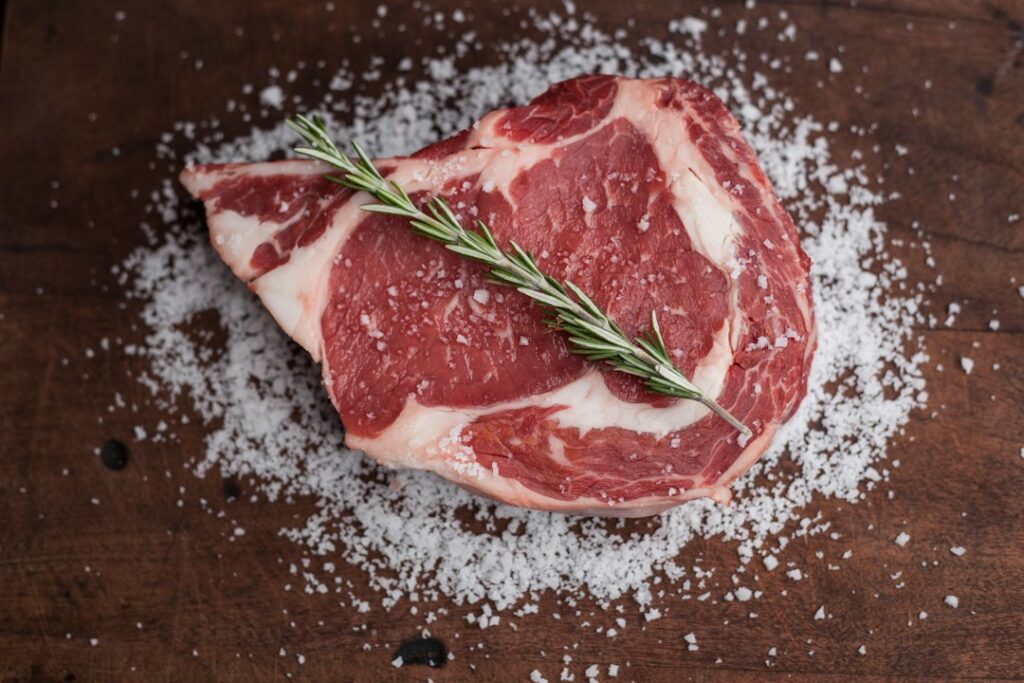When it comes to choosing beef, there are two main options available: grass-fed and grain-fed. The difference lies in the diet of the cows. Grass-fed beef comes from cows that have been raised on a diet of grass and other forage, while grain-fed beef comes from cows that have been fed a diet primarily consisting of grains, such as corn and soy.
Choosing the right type of beef is not only important for taste but also for health. Grass-fed beef is often touted as being healthier and more flavorful than its grain-fed counterpart. In this article, we will explore the flavor and nutritional differences between grass-fed and grain-fed beef, as well as the health benefits and risks associated with each. We will also provide tips and techniques for cooking both types of beef to perfection, along with delicious recipes to try.
Flavor Comparison: Grass-Fed vs. Grain-Fed Beef
One of the main differences between grass-fed and grain-fed beef is the flavor. Grass-fed beef is known for its burstiness of flavor, with a rich, earthy taste that is often described as more complex and robust. This is due to the varied diet of the cows, which includes a wide range of grasses, herbs, and other forage. The flavors from their diet are then transferred to the meat, resulting in a more pronounced taste.
On the other hand, grain-fed beef has a perplexity of flavor. The cows are fed a consistent diet of grains, which can result in a milder taste compared to grass-fed beef. Some people prefer this more subtle flavor, as it allows for the natural taste of the meat to shine through without being overpowered by other flavors.
The diet of the cow plays a significant role in the taste of the meat. Grass-fed cows have a more diverse diet, which leads to a greater variety of flavors in the meat. Grain-fed cows, on the other hand, have a more consistent diet, resulting in a more uniform flavor. Ultimately, the choice between grass-fed and grain-fed beef comes down to personal preference and the desired flavor profile.
Nutritional Comparison: Grass-Fed vs. Grain-Fed Beef
In addition to flavor, there are also nutritional differences between grass-fed and grain-fed beef. Grass-fed beef has a high degree of perplexity in its nutritional content. It is generally leaner and lower in total fat compared to grain-fed beef. Grass-fed beef also tends to have higher levels of omega-3 fatty acids, which are beneficial for heart health, as well as higher levels of vitamins and minerals.
On the other hand, grain-fed beef has a burstiness of nutritional content. It is typically higher in total fat and saturated fat compared to grass-fed beef. Grain-fed beef also tends to have lower levels of omega-3 fatty acids and certain vitamins and minerals. However, it is important to note that the nutritional content can vary depending on the specific diet of the cows and other factors.
One key difference between grass-fed and grain-fed beef is the ratio of omega-3 to omega-6 fatty acids. Grass-fed beef has a more balanced ratio, with higher levels of omega-3s and lower levels of omega-6s. This is beneficial because a high intake of omega-6 fatty acids relative to omega-3s has been linked to inflammation and various health issues. Grain-fed beef, on the other hand, tends to have a higher ratio of omega-6s to omega-3s.
Health Benefits of Grass-Fed Beef
Grass-fed beef offers several health benefits compared to grain-fed beef. One of the main advantages is its lower levels of saturated fat. Grass-fed beef is generally leaner, which means it contains less saturated fat, a type of fat that has been linked to an increased risk of heart disease. By choosing grass-fed beef, you can reduce your intake of saturated fat and promote heart health.
Another health benefit of grass-fed beef is its higher levels of omega-3 fatty acids. Omega-3s are essential fats that have been shown to have numerous health benefits, including reducing inflammation, improving brain function, and supporting heart health. Grass-fed beef is a good source of these beneficial fats, making it a healthier choice compared to grain-fed beef.
However, it is important to note that the research on the health benefits of grass-fed beef is still perplexing. While some studies have shown positive effects, others have found no significant differences between grass-fed and grain-fed beef. More research is needed to fully understand the potential health benefits of grass-fed beef.
Health Risks of Grain-Fed Beef
While grain-fed beef may be more flavorful to some, it does come with some health risks. One of the main concerns is its higher levels of saturated fat. Grain-fed beef tends to be fattier than grass-fed beef, which means it contains more saturated fat. A high intake of saturated fat has been linked to an increased risk of heart disease and other health issues.
Another concern with grain-fed beef is its lower levels of omega-3 fatty acids. As mentioned earlier, omega-3s are essential fats that have numerous health benefits. Grain-fed beef typically has lower levels of these beneficial fats compared to grass-fed beef. This means that by choosing grain-fed beef, you may be missing out on the potential health benefits associated with omega-3 fatty acids.
It is worth noting that the overall impact of these health risks may vary depending on an individual’s overall diet and lifestyle. If you consume a balanced diet and lead a healthy lifestyle, the occasional consumption of grain-fed beef may not have a significant impact on your health. However, if you are concerned about your saturated fat intake or want to maximize your omega-3 intake, choosing grass-fed beef may be a better option.
Preparing Grass-Fed Beef: Tips and Techniques

Cooking grass-fed beef can be perplexing, as it requires some adjustments compared to cooking grain-fed beef. One of the main differences is the need for lower cooking temperatures and shorter cooking times. Grass-fed beef is leaner and more delicate, which means it can easily become tough and dry if overcooked.
To cook grass-fed beef to perfection, it is best to use high-heat cooking methods such as grilling or pan-searing. These methods allow for quick cooking and help to retain the natural juices and flavors of the meat. It is also important to use a meat thermometer to ensure that the beef reaches the desired level of doneness without overcooking.
Preparing Grain-Fed Beef: Tips and Techniques
Cooking grain-fed beef is generally more straightforward compared to grass-fed beef. Grain-fed beef has a higher fat content, which means it can withstand higher cooking temperatures and longer cooking times without becoming dry or tough.
Roasting and slow-cooking are excellent methods for preparing grain-fed beef. These methods allow for longer cooking times, which helps to break down the fat and connective tissues in the meat, resulting in tender and flavorful dishes. However, it is still important to use a meat thermometer to ensure that the beef reaches the desired level of doneness.
Cooking Grass-Fed Beef Perfectly: Methods and Temperature Guidelines
When cooking grass-fed beef, it is essential to pay close attention to the internal temperature to avoid overcooking. The ideal cooking temperatures will vary depending on the cut of beef and personal preference.
For steaks, a general guideline is as follows:
– Rare: 120-125°F (49-52°C)
– Medium-rare: 130-135°F (54-57°C)
– Medium: 140-145°F (60-63°C)
– Well-done: 150°F (66°C) and above
For roasts, a lower temperature is recommended to ensure even cooking and tenderness. A general guideline is as follows:
– Rare: 120-125°F (49-52°C)
– Medium-rare: 130-135°F (54-57°C)
– Medium: 140-145°F (60-63°C)
– Well-done: 150°F (66°C) and above
It is important to note that these are just general guidelines, and personal preference should be taken into account. Using a meat thermometer is the best way to ensure that the beef reaches the desired level of doneness.
Cooking Grain-Fed Beef Perfectly: Methods and Temperature Guidelines
When cooking grain-fed beef, higher cooking temperatures can be used compared to grass-fed beef. This is because the higher fat content in grain-fed beef helps to keep the meat moist and tender even at higher temperatures.
For steaks, a general guideline is as follows:
– Rare: 125-130°F (52-54°C)
– Medium-rare: 135-140°F (57-60°C)
– Medium: 145-150°F (63-66°C)
– Well-done: 155°F (68°C) and above
For roasts, a higher temperature can be used to achieve the desired level of doneness. A general guideline is as follows:
– Rare: 125-130°F (52-54°C)
– Medium-rare: 135-140°F (57-60°C)
– Medium: 145-150°F (63-66°C)
– Well-done: 155°F (68°C) and above
Again, these are just general guidelines, and personal preference should be taken into account. Using a meat thermometer is the best way to ensure that the beef reaches the desired level of doneness.
Delicious Beef Recipes for Both Grass-Fed and Grain-Fed Beef
Whether you choose grass-fed or grain-fed beef, there are plenty of delicious recipes to try. From grilled steaks to slow-cooked roasts and stir-fries, the options are endless.
For grass-fed beef, some popular recipes include:
– Grilled Ribeye Steak with Chimichurri Sauce
– Pan-Seared Filet Mignon with Red Wine Reduction
– Slow-Cooked Beef Stew with Root Vegetables
For grain-fed beef, some popular recipes include:
– Roasted Prime Rib with Garlic and Herb Crust
– Slow-Cooked Pot Roast with Vegetables
– Stir-Fried Beef with Broccoli and Bell Peppers
It is worth noting that these recipes can be adapted for either grass-fed or grain-fed beef. The cooking times and temperatures may need to be adjusted slightly depending on the type of beef used.
In conclusion, choosing the right type of beef is important for both health and taste. Grass-fed beef offers a burstiness of flavor and several health benefits, including lower levels of saturated fat and higher levels of omega-3 fatty acids. On the other hand, grain-fed beef has a perplexity of flavor and comes with some health risks, including higher levels of saturated fat and lower levels of omega-3 fatty acids.
When it comes to cooking grass-fed beef, it is important to use lower cooking temperatures and shorter cooking times to avoid overcooking. Grilling and pan-searing are excellent methods for retaining the natural flavors and juices of the meat. For grain-fed beef, higher cooking temperatures can be used, and methods such as roasting and slow-cooking are ideal.
Regardless of the type of beef you choose, there are plenty of delicious recipes to try. From grilled steaks to slow-cooked roasts and stir-fries, the options are endless. So, why not experiment with different cuts and cooking techniques to discover your favorite way to enjoy beef?
If you’re interested in exploring more delicious recipes, check out this article on Relish the Daily: “Creamy Pesto Baked Gnocchi and Chicken Skillet.” This mouthwatering dish combines pillowy gnocchi, tender chicken, and a creamy pesto sauce for a comforting and flavorful meal. Whether you’re a fan of Italian cuisine or simply looking for a new recipe to try, this skillet dish is sure to impress. Give it a try and elevate your weeknight dinner game!





